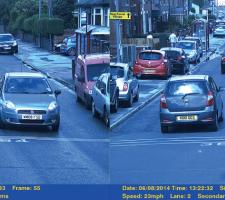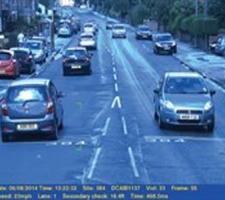
“In most instances the problem of speeding vehicles is not restricted to those travelling in one direction – it often applies to both directions,” says Peter Hill, operations director for Truvelo (UK). “While it is possible to swivel a camera to check vehicles travelling in one or the other direction, drivers will recognise which way the camera is pointing and then decide whether or not to comply with the limit.”
The new system overcomes this problem by using a single camera to simultaneously enforce two lanes where vehicles are travelling in opposite directions. Vehicles travelling towards the camera are photographed from the front while those travelling away from the installation are photographed from the rear, with the images marked to indicate in which lane the offending vehicle is travelling.
Triggering the camera is done by a sensor array set into the surface of each carriageway. This consists of three in-ground piezoelectric axle sensors in each carriageway to detect the vehicles and measure their speed. Secondary check markings are set at a specified distance from the sensors and appear in the enforcement images.
According to Hill, using in-ground piezoelectric sensors maximises accuracy because the positions of both the sensors and the secondary speed check lines are known precisely. The sensors also enable axle-based classification and automatic selection of a lower speed threshold where required, as well as identifying which lane the speeding vehicle is using and therefore which way it is travelling. The enforcement images contains a visual indication of which of the vehicles is of interest and, as per normal, this information is displayed in the data field of the photographs to be used as evidence.
Air gap
Both the images and data relating to offending vehicles are encrypted and transferred via an ADSL line or 3G connection and if this is not possible they can be downloaded to a shuttle PC as a transfer-only device on which the images cannot be viewed. All the data regarding the offending vehicles is fed into the system’s back office servers (capable of managing in excess of 25 D-Cams) the first of which stores and writes the encrypted data and images to a CD. The CD is then viewed on the second server (called the Truvelo’s Violation Manager) – a process which creates the ‘air gap’ required by the UK Home Office.The second server deciphers the encrypted images and data and from that point the information can be viewed and also moved across into whichever back office offence handling package is being used with compatible options including
In practice, to enforce speed limits in two-way traffic situations the centre line of each set of secondary check lines is aligned across both carriageways. In the lane travelling towards the camera these secondary speed check lines are typically situated 1.8m in front of the closest of the three piezoelectric sensors and the vehicle is photographed from the front. In the lane travelling away from the camera the secondary speed check lines are typically 5m from the sensor array in order that the rear axle of most vehicles will be on the lines, positioning the vehicle to be photographed from the rear. Hill says this system provides greater siting flexibility, particularly at intersections where there may already be in-ground sensors or where access chamber covers are present.
According to Hill, the cost of installing an additional array of sensors in order to create a simultaneous bi-directional site is negligible, compared to the additional traffic calming and enforcement benefits achieved. The D-Cam is also designed in order that it can be moved between sites to maximise operational flexibility and coverage. This includes circulating it between a mix of speed only sites and speed on green sites.
Less masking
For practical reasons the 3.4m tall camera post is always adjacent to the front photo lane and there is potential that such a vehicle can mask a speeding vehicle heading in the other direction from being photographed from the rear. However, Hill says that as the SBD system takes only a single photograph, this is less of a problem than with camera systems that use two photographs.One of the latest installations is in Central Bedfordshire in the UK where the Council officials have allocated capital to replace the existing wet-plate cameras to digital and to expand the automated enforcement network.
Paul Salmon, team leader for Traffic Management and Road Safety, said not only did the Council apply standard KSI figures to selection of new camera sites, it also looked to address the effects speeding motorists have on the lives of local residents. To do this it applied a metric of 35% of the two-way weekly traffic exceeding the Association of Chief Police Officers (ACPO) enforcement threshold (10% overspeed plus 2mph) for the posted speed limits. The result is that six SBD cameras are being installed at new sites around the county as well as the upgrades to the existing installations.
Salmon says the camera: “Does exactly what it says it will. At sites where we’ve used it, we get double the coverage, and double the impact, from a single camera and there was very little disruption during the upgrade to get the new cameras in and running.”
However, the first installation of the D-Cam SBD was in northern England when the West Yorkshire Casualty Reduction Partnership located the cameras along the A61 - a busy principal urban road between the Yorkshire cities of Wakefield and Leeds. This road, which is the responsibility of Wakefield Metropolitan District Council, passes through mixed residential and retail areas, and over a period of five years a 2.3km (1.4mile) section experienced 38 accidents - nine serious – in which speed was a major factor. While the posted limit is 48km/h (30mph), a week-long survey recorded a 90th percentile speed of 58.5km/h (36.4mph). To counter this two SBD-capable D-Cam cameras located approximately 800metres (0.5 mile) apart were commissioned in summer 2014.
West Yorkshire Casualty Reduction Partnership’s operations manager Zafar Iqbal said the SBD feature has proved capable of capturing speeding vehicles travelling in opposite directions within the same second.
Iqbal was initially attracted by the D-Cam’s front-facing capability (it has UK Home Office Type Approval for both front and rear photography). Although driver identification is not required by law in speeding offence cases, this has provided an additional intelligence tool and has already been used to provide assistance to crime officers. This happened when a vehicle is associated with a crime has been captured by the front photo camera and the image quality has been good enough to identify the driver and help secure a conviction.
Red light enforcement
In addition, the same camera can also be used for red light enforcement applications for vehicles travelling away from the installation. Once the amber grace period (typically three seconds) has passed, the lights turn to red with typically a 1 sec grace period, then the camera switches to red light enforcement mode and will capture two images of an offender. The first shows the speed and offending vehicle straddling the Stop bar.
A second photograph is taken when the vehicle is 12-15m (40-50ft) away (depending on junction size) and includes the image of the traffic lights to confirm that a red light offence has taken place.













